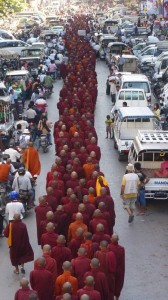10-16 December: Protest and Persecution Under the Guise of Reformist Laws
December 17, 2012 Last week saw protests spread across Burma against the deplorable treatment by the authorities against those who dared to oppose the Letpadaung copper mine. The reaction of the government was all too familiar, with more monks arrested for their participation in peaceful demonstrations.
Last week saw protests spread across Burma against the deplorable treatment by the authorities against those who dared to oppose the Letpadaung copper mine. The reaction of the government was all too familiar, with more monks arrested for their participation in peaceful demonstrations.
The incident at the Letpadaung copper mine near Monywa, Sagaing Region, saw riot police brutally break up an 11-day protest by activists and monks against the mine that is forcing people off their land and causing major environmental damage. The police stormed the protest camp in the middle of the night, used tear gas and incendiary devices to break up the rally and injured at least 65 monks, while arrests of activists were made in Rangoon.
Since the crackdown, in scenes reminiscent of the 2007 Saffron Revolution, thousands of monks marched peacefully down main streets of Rangoon, Mandalay, Myingyan, Monywa and other towns and cities. They demanded an apology for the violence from President Thein Sein, the unconditional release of those arrested, and legal action against the perpetrators of the violence. Their courage in the context of the threat of serious violence is typified by Abbot Thawbita, one of the monks demonstrating in Mandalay, who said, “We believe that if we accept this violence now, we will have to face more serious suppression.” Union Minister Hla Tun has apologized to some of the injured monks in a ceremony in Mandalay on 15 December, but this falls short of the monks’ demand that the President himself apologize. Meanwhile, those protesters arrested in Rangoon on 26 November and 2 December have been released on bail,but still face charges of inciting public unrest.
While visually, these protests are a reminder of the 2007 Saffron Revolution, the reaction of the authorities is also a reminder of the military regime. A second round of arrests on the night of 13 December of those involved in these protests, as well as the summoning of Ko Htin Kyaw to Pabedan and Kyauktada police stations for instigating a solo protest on 15 December reveals how little tolerance the government has of dissent. Despite ostensibly allowing protests to occur with the passing of the Law Relating to Peaceful Assembly and Peaceful Procession, the reality is that restrictions within this law serve to limit and prevent protests. Thus, a permit is required to be allowed to protest, although these are difficult to obtain, each individual protester must register with the police, and slogans need to be pre-approved by the authorities. This law violates international human rights standards, particularly those related to freedom of assembly and expression. According to Human Rights Watch, “it still allows the Burmese government to trump the Burmese people’s basic rights” yet it has been touted as a symbol of reform in Burma. It is under the stipulation that permission must be applied for before protests can be allowed that the activists were arrested on 13 December and in previous weeks.
The protests of the last week are symbolic in their comparison with those of 2007. The monks are still politically active and courageous in their stand while the authorities continue to detain and prosecute demonstrators and activists who support them. This time, however, the Burma government has flawed and deceptive laws to hide behind.
News Highlights
Court grants bail to Rangoon activists protesting against the Letpadaung copper mine, who still face trial on 24 December on charges of inciting unrest and Ashin Gambira is released on 4 million kyat (US$4,600) bail
Inside Burma
Parliament approves the Population and Housing Census Bill
Fighting between the Burma Army and the Kachin Independence Army heats up
Ta’ang National Liberation Army reports increased battles with the Burma Army in northern Shan State
Tavoy Deep Sea Port deal signing between Italian-Thai Development and the government is delayed
Regional
International
An investigation is launched into how new Swedish-made weapons entered Burma in breach of EU sanctions; Swedish Trade Minister says that weapons were originally sold to India
Opinion
International Praise and Grassroots Realities
By Nancy Hudson-Rodd
DVB
Latest from the Blog
Participation and Inclusion in Burma, Empty Words
By Burma Partnership
Actions
Statements and Press Releases
AIPMC Calls on Thai Authorities to Protect Basic Rights of Migrant Workers and Rohingya Asylum Seekers
By ASEAN Inter-Parliamentary Myanmar Caucus
Myanmar Military Remains an Obstacle to Progress, AIPMC Warns
By ASEAN Inter-Parliamentary Myanmar Caucus
CSW Calls for Increased Protection of Freedom of Religion or Belief on Human Rights Day
By Christian Solidarity Worldwide
New Report: Women Urge Halt to Expansion of Damaging Karenni Tin Mines
By Molo Women Mining Watch Network
Statement (8/2012) of the Myanmar National Human Rights Commission on the International Human Rights Day
By Myanmar National Human Rights Commission
New Survey: Communities Across Burma Denied Voice in Mega-Projects
By Students and Youth Congress of Burma and Nationalities Youth Forum
Reports
The Situation of Refugees on the Thai-Burma Border
By Burma Partnership
Landmine Death and Injuries, Old Mines Continue to Make Travel Unsafe in Pa’an District
By Karen Human Rights Group
Nyaunglebin Situation Update: Moo Township, June to November 2012
By Karen Human Rights Group
Woman Raped and Killed in Pa’an District, October 2012
By Karen Human Rights Group
Position on the Repatriation of Refugees from Burma
By Karenni Refugee Committee and Karenni Community Based Organizations
Lost Paradise: Damaging Impact of Mawchi Tin Mines in Burma’s Karenni State
By Molo Women Mining Watch Network
Excluded: Burma’s Ethnic Nationalities on the Margins of Democracy and Development
By Students and Youth Congress of Burma and Nationalities Youth Forum
This post is in: Weekly Highlights









 All posts
All posts